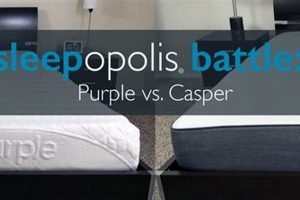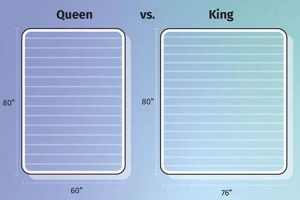The comparison between mattresses of varying thicknesses, specifically those measuring ten inches and twelve inches, focuses primarily on the impact of increased material on support, comfort, and overall longevity. Thicker mattresses generally incorporate a greater quantity of comfort and support layers.
A thicker mattress can potentially offer enhanced pressure relief, especially for side sleepers, and improved motion isolation, benefiting couples. Furthermore, a greater depth may contribute to a more substantial feel and potentially prolong the mattress’s lifespan due to increased resistance to compression over time. These factors have made mattress depth a key consideration for consumers seeking optimal sleep solutions.
The ensuing discussion will delve into specific differences in construction, suitability for various sleep positions and body types, and the associated cost implications of choosing between a ten-inch and a twelve-inch mattress.
Guidance on Mattress Thickness Selection
The following guidance provides insights into selecting a mattress based on thickness, considering factors that influence comfort and support.
Tip 1: Assess Individual Body Weight: Heavier individuals generally benefit from thicker mattresses (12 inches or greater) due to the enhanced support and reduced risk of bottoming out. Lighter individuals may find a 10-inch mattress adequate.
Tip 2: Consider Sleep Position: Side sleepers typically require a thicker comfort layer to alleviate pressure on hips and shoulders. A 12-inch mattress often provides greater cushioning for this sleep position.
Tip 3: Evaluate Support Core Density: Regardless of thickness, the density of the support core (e.g., coils or foam) significantly impacts the level of support. A higher density core is crucial for spinal alignment.
Tip 4: Examine Comfort Layer Materials: The type of materials used in the comfort layer (e.g., memory foam, latex) influences pressure relief and temperature regulation. Consider personal preferences for these factors.
Tip 5: Factor in Bed Frame Height: The combined height of the mattress and bed frame should be considered for ease of getting in and out of bed. A thicker mattress will increase the overall bed height.
Tip 6: Budgetary Considerations: Thicker mattresses generally incur a higher cost due to the increased material usage. Balance desired features with affordability.
Tip 7: Account for Partner Preferences: If sharing the bed, consider the needs and preferences of both individuals when selecting mattress thickness.
Careful consideration of these factors allows for a more informed decision when choosing between a ten-inch and twelve-inch mattress, optimizing sleep quality and comfort.
The subsequent sections will explore specific mattress types and their performance characteristics, further assisting in the selection process.
1. Support core density
Support core density constitutes a critical factor in evaluating mattress performance, particularly when discerning between ten-inch and twelve-inch models. The density of materials used within the support core directly influences the degree of support, durability, and overall feel of the mattress.
- Impact on Spinal Alignment
A high-density support core, irrespective of mattress thickness, provides greater resistance to compression and maintains spinal alignment. Inadequate density can lead to sagging and improper spinal positioning, potentially causing discomfort and back pain. Both ten-inch and twelve-inch mattresses benefit from a high-density core to ensure adequate support.
- Influence on Durability
Mattresses with higher density cores typically exhibit greater resilience over time. The denser the material, the less prone it is to degradation and permanent compression. A twelve-inch mattress, while inherently thicker, does not guarantee superior durability if its core density is lower than that of a ten-inch mattress with a high-density core.
- Relationship to Weight Distribution
A dense support core effectively distributes weight across the mattress surface, minimizing pressure points. This is particularly important for heavier individuals or those with pre-existing musculoskeletal conditions. While a thicker mattress may offer more overall cushioning, the density of its support core determines its ability to evenly distribute weight.
- Material Composition Considerations
Support cores are commonly composed of high-density foam or innerspring coils. The density of foam cores is measured in pounds per cubic foot (PCF), with higher values indicating greater density. For innerspring cores, coil gauge and coil count are indicators of density and support. The material and construction of the support core impact the overall feel and responsiveness of the mattress, regardless of its thickness.
In summary, while mattress thickness is a salient factor, the density of the support core is a paramount determinant of support, durability, and spinal alignment. A discerning consumer should prioritize core density alongside thickness when selecting a mattress, as the former significantly influences the long-term performance and comfort of the sleep surface.
2. Comfort layer thickness
Comfort layer thickness represents a primary differentiating factor between ten-inch and twelve-inch mattresses, directly impacting pressure relief, surface feel, and overall sleep experience. The depth of the comfort layer influences its ability to contour to the body, absorb pressure, and provide cushioning.
- Pressure Relief Capability
A thicker comfort layer generally enhances pressure relief, particularly for side sleepers. Increased material allows for greater compression and distribution of body weight, minimizing stress on pressure points such as hips and shoulders. A twelve-inch mattress, with a typically thicker comfort layer, often outperforms a ten-inch mattress in this regard.
- Surface Feel Modulation
Comfort layer thickness directly influences the initial feel of the mattress. A thicker layer provides a plusher, more enveloping sensation, while a thinner layer offers a firmer, more responsive surface. Individual preference dictates the ideal feel, but a thicker layer may be advantageous for those seeking enhanced cushioning.
- Temperature Regulation Effects
Comfort layer materials and thickness impact temperature regulation. Thicker layers, especially those composed of memory foam, can trap heat. Conversely, thinner layers or materials with open-cell structures promote airflow and reduce heat retention. The interplay between thickness and material selection determines the thermal properties of the mattress.
- Long-Term Performance Considerations
The thickness of the comfort layer influences its long-term durability and resistance to compression. Thicker layers generally exhibit greater resilience and maintain their shape and support characteristics over time. However, the quality of the materials used is also crucial, as a thicker layer composed of low-density foam may degrade more rapidly than a thinner layer of high-density foam.
In summary, comfort layer thickness is a crucial aspect to evaluate when comparing ten-inch and twelve-inch mattresses. A thicker layer generally offers enhanced pressure relief and a plusher feel, but material composition and temperature regulation must also be considered. The optimal thickness depends on individual preferences and sleep needs.
3. Edge support quality
Edge support quality represents a significant, yet often overlooked, aspect when comparing ten-inch and twelve-inch mattresses. Superior edge support mitigates the common issue of edge collapse, which can reduce the usable sleep surface and compromise overall mattress stability. The differential in mattress thickness can influence the engineering and materials used to create robust edge support. For instance, a twelve-inch mattress may incorporate thicker gauge coils or higher-density foam encasements around the perimeter, compared to a ten-inch model, to counteract potential compression under weight. This enhanced edge support translates to a more consistent sleep surface and improved ease of entry and exit from the bed.
The practical significance of edge support is particularly evident for couples sharing a bed and individuals who tend to sleep near the edge. Inadequate edge support can create a “roll-off” sensation, leading to disrupted sleep and a feeling of instability. Furthermore, strong edge support prolongs the lifespan of the mattress by preventing premature sagging and deformation around the perimeter. A real-life example would be an individual who relies on the edge of the mattress for support while sitting to get dressed; a mattress with poor edge support will quickly degrade in this area. A firmer, more supportive edge allows for comfortable sitting and minimizes wear and tear on the mattress core.
In conclusion, while both ten-inch and twelve-inch mattresses can incorporate edge support features, the thicker profile of the latter often allows for more substantial reinforcement, resulting in improved stability, increased usable sleep surface, and prolonged mattress longevity. The effectiveness of edge support depends not only on thickness but also on the quality and density of materials used in its construction. Therefore, consumers should carefully evaluate the edge support system when selecting between mattresses of varying thicknesses to ensure optimal sleep comfort and mattress durability.
4. Motion isolation potential
Motion isolation potential, a critical aspect of mattress performance, refers to the ability of a mattress to minimize the transfer of movement from one area of the bed to another. This characteristic is particularly important for couples, as it prevents disturbances caused by a partner’s tossing, turning, or getting in and out of bed. The relationship between motion isolation and mattress thickness, specifically when comparing ten-inch and twelve-inch models, lies primarily in the increased capacity for incorporating dampening materials within the thicker mattress. A twelve-inch mattress may offer greater motion isolation due to the potential for thicker layers of memory foam or other viscoelastic materials, known for their ability to absorb and dissipate energy. For instance, a couple where one partner is a restless sleeper may find that a twelve-inch mattress with a substantial memory foam comfort layer provides superior motion isolation compared to a ten-inch mattress with a thinner or less responsive comfort layer.
The type and arrangement of materials within the mattress construction also play a crucial role in motion isolation. While a thicker mattress may inherently offer more space for motion-isolating materials, the design and composition of these materials are paramount. A ten-inch mattress with a well-engineered combination of latex and individually wrapped coils may, in some cases, outperform a poorly designed twelve-inch mattress with inferior materials. Furthermore, hybrid mattresses, which combine foam and coil systems, often require careful engineering to balance support with motion isolation, regardless of their thickness. Practical application of this understanding involves considering not just the overall thickness but also the specific materials and construction techniques employed within the mattress.
In conclusion, while a twelve-inch mattress may offer a higher potential for motion isolation due to the increased space for dampening materials, the actual performance depends heavily on the materials used and the overall design. Consumers should prioritize specific mattress features and construction techniques known to enhance motion isolation, rather than solely relying on thickness as an indicator. The effectiveness of motion isolation has a direct impact on sleep quality and the ability of partners to sleep undisturbed.
5. Overall height implications
The choice between a ten-inch and twelve-inch mattress directly affects the overall bed height, influencing accessibility, aesthetics, and potential compatibility with existing bedroom furniture. A thicker mattress increases the distance from the floor to the sleep surface, a factor of particular importance for individuals with mobility limitations or those of shorter stature. For example, an elderly person or someone recovering from surgery may find it more difficult to get in and out of a bed with a combined mattress and foundation height that is excessively tall. Conversely, a bed that is too low can also present challenges for individuals with joint pain or back problems.
The change in height resulting from choosing a thicker mattress also impacts the visual proportions of the bedroom. A significantly thicker mattress may obscure the headboard, disrupting the intended aesthetic. Furthermore, the height of nightstands relative to the mattress surface becomes critical for functionality. A nightstand that is too low will be difficult to use comfortably, while one that is too high may look disproportionate. The selection of bedding, such as bed skirts and comforters, also requires adjustment based on the overall bed height to ensure a proper fit and visual balance within the room.
Therefore, the selection between a ten-inch and twelve-inch mattress should not solely focus on comfort and support considerations. Careful assessment of the overall height implications, considering existing furniture and individual physical needs, is crucial to ensure optimal functionality, accessibility, and aesthetic harmony within the bedroom. Neglecting this factor can result in discomfort, inconvenience, and visual disharmony, detracting from the overall sleep environment.
6. Pressure relief capability
Pressure relief capability constitutes a critical performance characteristic when differentiating between ten-inch and twelve-inch mattresses. It determines the mattress’s ability to minimize pressure points and distribute body weight, directly impacting comfort and sleep quality. The following explores facets of pressure relief in relation to varying mattress thicknesses.
- Comfort Layer Thickness and Composition
A thicker comfort layer, often found in twelve-inch mattresses, generally provides enhanced pressure relief. This is attributable to the increased volume of cushioning material, allowing for greater conformity to body contours and reduced stress on pressure points like hips and shoulders. The specific materials used (e.g., memory foam, latex) further influence pressure relief effectiveness. For instance, a twelve-inch mattress with a thick memory foam layer will likely offer superior pressure relief compared to a ten-inch mattress with a thinner layer of less responsive foam.
- Support Core Interaction
The support core’s design and density influence how the comfort layer performs its pressure-relieving function. A supportive core prevents excessive sinking, ensuring the comfort layer can effectively contour to the body without bottoming out. A twelve-inch mattress with a robust support core can maintain optimal alignment and pressure distribution, even with a substantial comfort layer. In contrast, a ten-inch mattress with a less supportive core may compromise pressure relief if the comfort layer compresses excessively.
- Adaptability to Sleep Position
Pressure relief requirements vary depending on sleep position. Side sleepers, for example, typically require greater pressure relief in the shoulder and hip areas than back sleepers. A twelve-inch mattress may be better suited to accommodate the needs of side sleepers due to its increased cushioning capacity. A ten-inch mattress, while potentially adequate for back sleepers, may not provide sufficient pressure relief for side sleeping, leading to discomfort and potential pain.
- Weight Distribution Efficiency
Effective pressure relief relies on even weight distribution across the mattress surface. A thicker mattress, particularly one with zoned support, can better distribute weight and minimize pressure concentrations. Zoned support involves varying the firmness of different areas of the mattress to provide targeted support and pressure relief. A twelve-inch mattress with zoned support can offer customized comfort and pressure relief for different body regions, enhancing overall sleep quality. In contrast, a ten-inch mattress with uniform support may not adequately address individual pressure points.
In summary, the pressure relief capability of a mattress is intricately linked to its thickness, composition, and support structure. While a twelve-inch mattress often provides enhanced pressure relief due to its increased cushioning capacity, the specific materials and design features ultimately determine its effectiveness. Consumers should carefully evaluate their individual sleep needs and preferences when selecting between ten-inch and twelve-inch mattresses to ensure optimal pressure relief and sleep comfort.
Frequently Asked Questions
The following addresses common inquiries regarding the differences between mattresses with varying thicknesses, specifically ten-inch and twelve-inch models.
Question 1: Does a thicker mattress invariably provide superior comfort?
A thicker mattress does not automatically guarantee enhanced comfort. While increased material may allow for more substantial comfort layers, the density and quality of the materials used are paramount. A ten-inch mattress with high-density foam or advanced coil systems can, in some instances, offer comparable or even superior comfort to a twelve-inch mattress constructed with lower-quality materials.
Question 2: Is a twelve-inch mattress always more supportive than a ten-inch mattress?
Thickness is not the sole determinant of support. The support core’s construction, including coil gauge, coil count, or foam density, plays a critical role. A ten-inch mattress with a high-density support core can provide greater support than a twelve-inch mattress with a less robust core.
Question 3: Does mattress thickness directly correlate with mattress durability?
While a thicker mattress may potentially offer greater longevity due to the increased volume of material, durability is primarily influenced by the quality and density of the components used. A ten-inch mattress constructed with high-quality, durable materials may outlast a twelve-inch mattress with inferior materials.
Question 4: Are twelve-inch mattresses invariably better for side sleepers?
Twelve-inch mattresses often provide more substantial comfort layers, which can benefit side sleepers by alleviating pressure on hips and shoulders. However, the ideal mattress for a side sleeper depends on individual body weight and personal preferences. A ten-inch mattress with a well-designed comfort layer may also adequately accommodate side sleepers.
Question 5: Do thicker mattresses offer enhanced motion isolation capabilities?
The potential for motion isolation increases with mattress thickness due to the possibility of incorporating more dampening materials. However, the type and arrangement of these materials are crucial. A ten-inch mattress with strategically placed motion-isolating components can achieve comparable performance to a twelve-inch mattress.
Question 6: Does a thicker mattress always justify a higher price point?
A higher price for a thicker mattress is often associated with the increased material usage and potentially enhanced features. However, pricing should also reflect the quality of materials, construction techniques, and brand reputation. It is advisable to compare mattresses based on their specifications and performance characteristics, rather than solely relying on thickness as a price indicator.
In summary, mattress thickness is but one factor to consider when evaluating comfort, support, durability, motion isolation, and overall value. Careful assessment of material quality, construction, and individual needs is essential for making an informed decision.
The following section will offer a concluding perspective.
Conclusion
The preceding analysis of the “10 inch mattress vs 12 inch” dichotomy reveals that mattress thickness, while a significant factor, does not operate in isolation. The performance of a sleep surface hinges on a complex interplay of material quality, construction techniques, and individual physiological needs. Enhanced pressure relief, motion isolation, and durability, often associated with thicker mattresses, remain contingent upon the specific attributes of the materials employed and the engineering principles applied.
Ultimately, the selection between a ten-inch and twelve-inch mattress necessitates a comprehensive evaluation beyond mere dimensional specifications. Consumers are advised to prioritize a meticulous assessment of core density, comfort layer composition, edge support integrity, and overall construction quality. Informed decisions, predicated on a thorough understanding of these critical parameters, will yield the most satisfactory outcomes, promoting optimal sleep health and long-term value.







